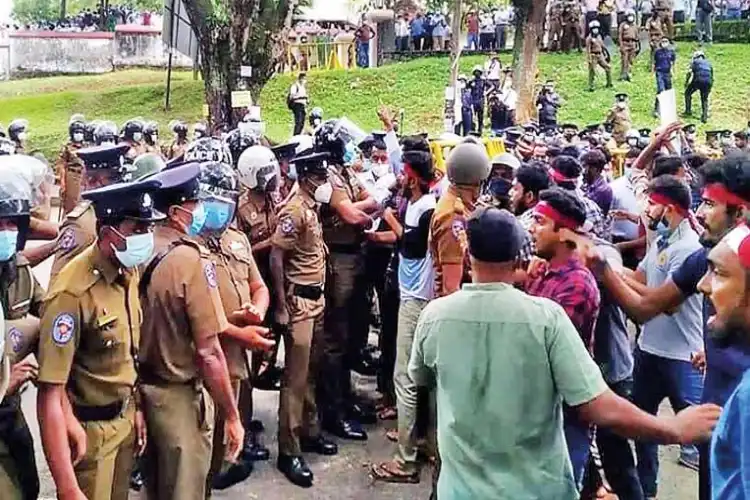
 Sushma Ramachandran
Sushma Ramachandran
India’s southern neighbour, Sri Lanka, has been hit by an economic crisis of tsunami-like dimensions. Soaring inflation, along with depleted foreign exchange reserves have meant that the island country which depends on imports for most of its needs, is facing shortages of nearly all items of mass consumption. Fuel is becoming a scarce commodity while electricity shortages have led to many hours of power cuts. A trickle of Sri Lankan refugees has begun landing on Indian shores but this could well transform into a flood in case the situation does not ease shortly.
The genesis of the crisis goes back to 2019 when the country was faced with a terrorist attack. This affected tourism, one of the main revenue earners for the economy. The industry should have revived after a few months but with the pandemic in early 2020, travel and tourism came to a halt all over the world. As a result, it was not possible for the country’s large hospitality industry to get back to normal for the past two years.
The other major revenue earners for the Sri Lankan have been tea and rice exports. These were given a body blow in mid-2021 when the government led by President Gotabaya Rajapaksa, decided to ban all forms of chemical fertilizers. The sudden shift to organic farming hit the output of both tea and rice. Tea exports had to be curtailed owing to the non-availability of the commodity while rice had to be imported to meet the country’s needs. Rice is a staple food item in that country and till last year, the country was self-sufficient in production. The ban on chemical fertilizers has now been partially lifted but urea imports continue to be disallowed.
To add to the country’s woes, the Rajapaksa government made deep tax cuts leading to revenue shortfalls, and these, in turn, widened the budget deficits. Foreign debt which constituted 42 percent of GDP in 2019, shot up to 119 percent in 2021. Foreign exchange reserves have fallen to 2.3 billion dollars while debt repayments due at the end of 2022 are estimated at 4 billion dollars. The currency has also been devalued by the central bank, as a precursor to seeking multilateral assistance.
Against this backdrop, the common man is in dire straits. Hospitals are running out of medicines while examinations cannot be held due to a lack of paper. The cost of essentials has soared to stratospheric levels. The economic emergency has been followed by a political one as the Rajapaksa government has lost its majority in Parliament owing to its inability to deal with the upheaval.
India, on its part, has reached out to help the island nation. After providing a one-billion-dollar line of credit to help pay for essential imports, it is likely to extend another 1.5 billion dollars in response to a request from the Sri Lankan government. It has already extended a 400-million-dollar currency swap and 500-million-dollar credit line for fuel purchases to the crisis-hit economy. It has also sent shipments of urgently needed diesel and rice.
While this country is prepared to offer even more aid to its neighbour, there is considerable concern over the past reliance on assistance from China. Though some analyses blame China for the debt crisis, other studies like those of the Australian Lowy Institute note that external debt owed to China was only about ten percent of the debt stock in April 2021. The European Foundation for South Asian studies, on the other hand, has asserted that the country’s foreign exchange reserves are shrinking partly due to unprofitable construction projects built with Chinese loans. But there has apparently been little response to Sri Lanka’s plea to China for rescheduling its debt burden.
India, in contrast, recognizes that a crisis in its neighbourhood can have ramifications for its own economy. The impact could be in various ways. The first is the prospect of a flood of refugees arriving here in a bid to flee from the harsh conditions prevailing in that country. It must be pointed out, however, that till now the per capita GDP in Sri Lanka was considerably higher than in India. It was 12,870 dollars in terms of purchasing power parity as compared to 6390 PPP dollars for India. In other words, a thriving economy has now been driven to face an economic emergency. According to World Bank estimates, the pandemic had already plunged 5 lakh citizens of that country below the poverty line. The situation must have gotten even worse over the past six months.
The impact on India will also be in terms of logistics issues which are critical in increasing trade flows. The country is heavily dependent on Colombo port for global trade as over 60 percent of transshipment is handled by it. The island nation is also a major trading partner, buying about 4.8 billion dollars worth of goods every year, accounting for 1.3 percent of total exports.
The economic crisis is also likely to impact Indian investments in Sri Lanka. These are wide-ranging in the areas of tourism, real estate, manufacturing, communications, and petroleum. In fact, some of the biggest companies in the country have invested in the southern neighbour.
Also Read: Arjuna Ranatunga lauds Modi for help during Lankan economic crisis
Apart from the economic linkages, there are longstanding traditional ties between the two countries which include the large Tamil population in that country. Though there is a well-known history of strife over the creation of the Tamil Eelam, strategic and economic relations between the two countries remain very close. Thus, there is no doubt the government will do its utmost to provide support to ensure that the economy does not suffer a complete collapse. But Sri Lanka will probably require the kind of massive assistance that can only be provided by the International Monetary Fund (IMF). The latest reports are that the finance minister may begin talks soon for a loan from the Fund. It may come with some stringent conditionalities by way of changing the country’s economic policies in the short run. But it will likely end up bringing the battered economy back on its feet and provide succor to the masses facing distress.
